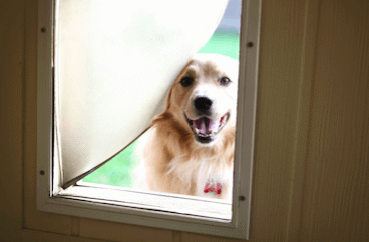Pet doors are a great invention. A door for your dog or cat allows it to go outside to take care of business without you having to get up and open the door. These doors can have a downside, however. That hole in your exterior wall isn't the best way to add ventilation to your home. It could be leaking energy, depending on the kind of door you have and how tightly it is installed.
CHOOSE YOUR PET DOOR CAREFULLY
Pet doors come in many sizes and designs. Generally, the more you pay, the better the door. For instance, a door with thick plastic double flaps that lock in place with magnets after the pet passes through will cost more but will make your home more efficient and save money on your utility bill. The double flaps lock in a volume of air that provides insulation and keeps outside air from entering the home; the trapped air also helps keep conditioned air inside the home. The magnets on the flaps ensure the doors don't move when it's windy. You can get even more energy efficiency by choosing a pet door with triple flaps.
BEST FEATURES FOR A PET DOOR
Here are some suggestions for your next pet door.
1. Choose an aluminum frame. Aluminum won't rust or corrode.
2. Pet doors that sense a key in your pet's collar allow only your pet inside. Some doors are designed to work with your pet's already programmed microchip. These doors will help keep out other cats, as well as unwelcome critters such as rats, raccoons and skunks.
3. If you have a bigger dog, you may want to invest in a secure locking feature for your larger pet door to prevent burglars from entering your home.
4. If you're gone a long time during the day, you may want to invest in a smart pet door. You can program it for the times of the day you want to let your pet outside.
For more about energy efficiency, contact Valley Heating, Cooling, Electricaland Solar. We serve Silicon Valley.
Our goal is to help educate our customers in the South Bay Peninsula and Santa Cruz areas of California about energy and home comfort issues (specific to HVAC systems).

